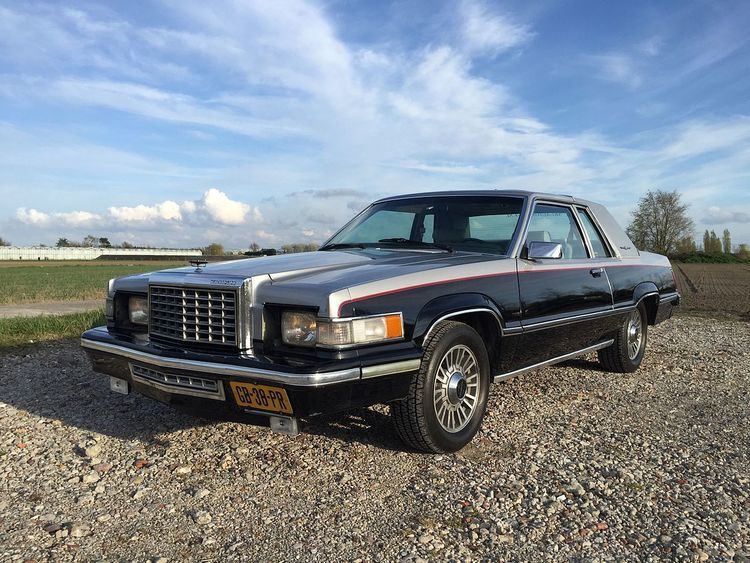Model years 1980-1982 | Production 1979–1982 Body style 2-door coupe | |
 | ||
Assembly Lorain, OhioChicago, IllinoisWixom, MichiganHapeville, Georgia | ||
The eighth generation of the Ford Thunderbird is a personal luxury coupe built by Ford from the 1980 to the 1982 model years. In response to changing market conditions, the Thunderbird again underwent major downsizing. Again a counterpart of the Mercury Cougar, the Thunderbird now derived its underpinnings from the Fox platform, the basis of the Ford Fairmont; it also marked the return to unibody construction. For the first time since 1960, it was again a four-seat automobile.
Contents
The 1980-1982 Thunderbird serves as an example of one of the most radically downsized automobiles in the North American industry. In comparison to its 1979 predecessor, it would be 16 inches shorter and 900 pounds lighter; compared to the 1976 model of only four years prior, it had shed over two feet in length and up to 1800 pounds (a full third) of curb weight.
Design history
For the 1977 model year, Ford shifted the Thunderbird from its traditional role as a companion model to the Lincoln Mark coupes to that as a competitor for the Chrysler Cordoba and various General Motors coupes ranging from the Pontiac Grand Prix to the Oldsmobile Cutlass Supreme. As the replacement for the relatively obscure Elite, the first downsized Thunderbird was a sales success, selling over 950,000 vehicles. However, by 1979, the Torino-based Thunderbird was an obsolete model. During the 1978 and 1979 model years, General Motors had downsized all of its mid-size vehicles to nearly the same size of its "compact" sedans. Additionally in 1979, Ford introduced a downsized full-size LTD; while 8 inches shorter than the Thunderbird, it boasted larger interior room.
In response, Ford readied an all-new Thunderbird for 1980. In what would prove a disastrous move, many of the design elements from the 1977-1979 Thunderbird were carried almost directly onto the smaller car, including the grille and taillights; hidden headlamps were included. Several rooflines were available, with padded landau roofs to mimic the B-pillar of the 1977-1979 generation.
To save development costs, the 1980 Thunderbird utilized the Fox platform with a unique exterior design that would only be shared with the Mercury Cougar XR7. While the Thunderbird itself was distinctly to be a luxury car, the use of the Fox platform would prove beneficial in improving the handling of the vehicle. Along with the massive weight reduction, the 1980 Thunderbird was the first to be fitted with rack-and-pinion steering, greatly improving steering precision; sharing the underpinnings of the Fairmont meant the use of MacPherson struts for the front suspension. Further in contrast to its personal-luxury background, a specially-tuned suspension package was designed to make use of Michelin TRX tires; Recaro bucket seats were an option.
1980
For its 25th anniversary, an all-new Thunderbird was introduced for the 1980 model year. Along with the standard and Heritage trims carried over from 1979, the Town Landau was introduced as the top-trim model. For the first time in a Ford, digital instrumentation was available along with an all-new feature called Keyless Entry System; a 5-button keypad mounted on the driver's door, it would become a feature seen on many Ford and Lincoln-Mercury vehicles for many years. Although one of the very last vehicles available with functional vent windows, many Thunderbirds came equipped with power windows.
Silver Anniversary Edition
To commemorate its 25th anniversary of production, Ford offered as a "Silver Anniversary Edition" of the Thunderbird. The external color scheme was called "Anniversary Glow Silver" and the interior was a silver/gray velour with optional leather available. The standard list of features was very comprehensive including the 302 V-8 as standard, as well as a host of luxury trim and convenience options above what the "Town Landau" model offered. Standard features included a garage door opener and a unique landau roof treatment with unique trim and exterior model designation badging.
Unlike most of its Fox-platform counterparts, the Thunderbird shared its powertrain with the full-size line. Two V8 engines were available: a 115 hp 255 cubic-inch V8 and a 131-hp 302 V8. To better utilize the power output, Ford paired both engines with the 4-speed AOD overdrive automatic transmission sourced from the LTD.
1981
Late in the 1980 model year, Ford began to offer the Thunderbird with a six-cylinder engine for the first time. Technically a delete option, the Thunderbird was now available with an 88 hp 200 cubic-inch inline-six sourced from the Fairmont/Granada; it was paired with a 3-speed automatic transmission. This would also be the last year for the 302 V8.
1982
In its last year, the Thunderbird saw very little change, except for engine offerings. The 302 V8 was dropped, with the 255 becoming the only V8 available. In the place of the inline-6, Ford introduced an all-new 112-hp 3.8L V6. In various forms, this engine would power the Thunderbird until its 1997 cancellation.
Powertrain
The base engine was a 4.2 L (255 cu in V8), or an optional 140 hp (104 kW) 5.0 L (302 cu in) Windsor V8. A 3.3 L (201 cu in) I6 was offered as a delete option in late built 1980 models and became the standard powerplant in 1981. The 3.8 L (232 cu in) V6 was made available as an option in 1982, and the 4.9 L (302 cu in) Windsor 5.0 V8 was dropped.
